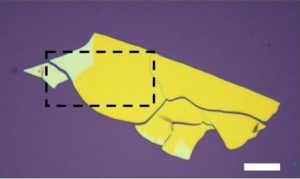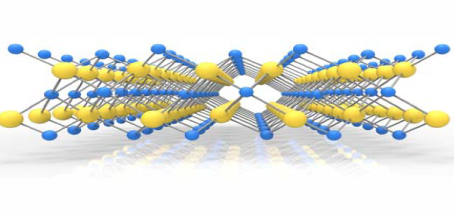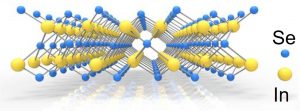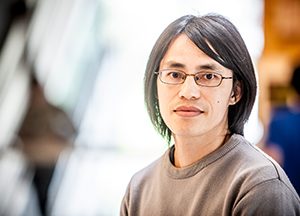 The discovery of new ferroelectric properties in the novel, layered material Indium(III) selenide (β’-In2Se3) enhances this material’s candidacy for non-volatile memory and low-power electronic and optoelectronic switches.
The discovery of new ferroelectric properties in the novel, layered material Indium(III) selenide (β’-In2Se3) enhances this material’s candidacy for non-volatile memory and low-power electronic and optoelectronic switches.
FLEET researchers at Monash University and UNSW were on the Australian-Chinese team that confirmed in-plane ferroelectricity in the material, β’-phase In2Se3.
In2Se3 belongs to a class of layered materials known as van der Waals (vdW) materials, which offer great promise for optoelectronic and electronic devices, for example for ultra-low energy electronics and non-volatile memories.
VdW materials have the potential to form paths with low resistance or a small energy barrier, along which different ferroelectric states can be switched with minimum energy dissipation.
The challenge is to be able to ‘switch’ that dissipationless channel off and on, thus allowing the binary control (off = 0, on = 1) intrinsic to transistors and computing.
The property of ferroelectricity is one useful switching mechanism, allowing a spontaneous electric polarisation that can be reversed by application of an external electric field.
Previously, very few vdW materials have been found with ferroelectric properties. And in particular, ferroelectricity in the same plane as the layers of atoms within the material is very rare. This is the first reported it has been observed in van der Waals layered materials. (Ferroelectricity perpendicular to the layers of the atoms has been previously observed.) This increases the material’s possible future applications.
The study Room temperature in-plane ferroelectricity in van der Waals In2Se3 was published in Science Advances in July 2018.
Indium(III) selenide (In2Se3) is a compound of indium and selenium, often studied for potential in photovoltaic devices. ‘β phase’ refers to a rhombohedral structure; one of five possible crystal phases.
The material’s is classified as van der Waals (vdW) material, comprised of layers of 2D atomic ‘sheets’, with the separate layers bound together by weak intermolecular forces. Graphene is the most famous vdW material, and it is the ability to easily ‘sheer apart’ graphene’s layers, breaking the weak forces, that makes it such an effective lubricant, and makes your pencil work!
This new study opens new areas of potential application for the material, which has previously been applied to phase-change random access memories, high-photoresponsivity photodetectors, and thermoelectrics.
Potential applications and study of novel materials at FLEET
The discovery of in-plane ferroelectricity in vdW In2Se3 adds new prospects for nonvolatile switching of the electronic and optical properties of In2Se3 or other vdW materials in heterostructures incorporating In2Se3.
Such vdW materials and heterostructures are keenly studied at FLEET, an Australian Research Council Centre of Excellence, within the Centre’s Enabling technology A.
The Centre for Future Low-Energy Electronics Technologies (FLEET) brings together over a hundred Australian and international experts, with the shared mission to develop a new generation of ultra-low energy electronics.
The impetus behind such work is the increasing challenge of energy used in computation, which uses 5–8% of global electricity and is doubling every decade.
FLEET personnel involved: Changxi Zheng (lead author), James Collins, Mark Edmonds, Jan Seidel, Michael Fuhrer.
Research highlights:
- First in-plane ferroelectric vdW material
- Demonstrated linear dichroism of ferroelectric domains in 𝛽’-In2Se3
- Clarified that phase 𝛽’-In2Se3 was ferroelectric , not a charge density wave as previously thought
- Demonstrated that 𝛽’ phase in bulk is stable at room temperature
- Developed novel tilted low energy electron microscopy (LEEM) imaging technique to obtain strong domain contrast for in-plane ferroelectricity
- Using LEEM, first imaging of phase transition of 𝛽′↔𝛽 in real space and real time, observing highly anisotropic phase transition behaviour
- First scanning tunnelling microscopy images of 1D superstructures of 𝛽’ phase, showing alternating fourth and fifth periodicity
Acknowledgements The research was led by Prof Wen-Xin Tang at Chongqing University, China, Changxi Zheng while working in Monash Engineering Faculty of Engineering, and Michael Fuhrer, Monash University Faculty of Science. Some funding was provided by the Australian Research Council (ARC) Discovery Early Career Researcher Award and Discovery Projects scheme. Piezoresponse force microscopy measurements (confirming ferroelectricity in air at room temperature) were performed by FLEET UNSW CI Jan Siedel and his student Dohyung Kim.
More information
- Contact Changxi Zheng Changxi.Zheng@monash.edu
- Contact Prof Michael Fuhrer michael.fuhrer@monash.edu
- Contact FLEET media@FLEET.org.au
- Visit FLEET.org.au
- Watch Future solutions to computation energy use
- Connect @FLEETCentre
- Subscribe FLEET.org.au/news



